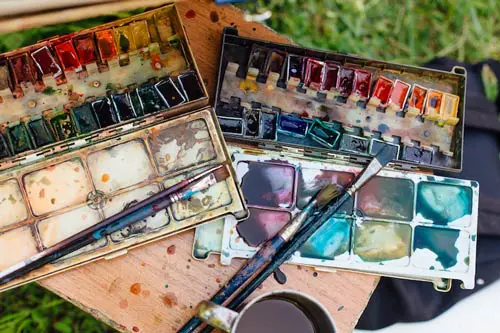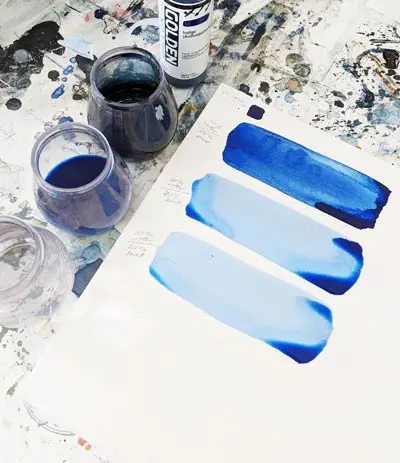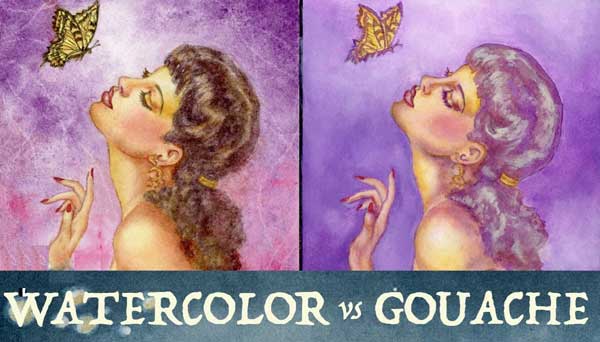Watercolor vs. Gouache – Know Actual Difference Between Them
Gouache and Watercolor are two similar styles of painting that both make use of water and water-soluble pigments and binders.
While Watercolor is a popular choice of painting method for most artists, Gouache, on the other hand, does not share that same level of acclaim. More so, it is only popular among specific categories of artists, such as illustrators and architects.
Both Watercolor and Gouache make use of water, sharing traits that make them nearly identical.
No doubt, it is tough for a layman to see anything different between Watercolor and Gouache .
An experienced artist or anyone with a decent knowledge of art and different art styles will be able to discern the subtle differences that exist between these two styles of painting.
Here, we take an in-depth look into these two styles of painting, their origins and popularity, and the beautiful features that make them distinct and separate.
Watercolor: Quick Overview and History
Watercolor is a method of painting involving mixing color pigments in water or a water-based solution. The paint is created by suspending the pigment particles in water using a binder or gum. The dried sap of the acacia tree, known as gum arabic, is usually used as a binder in the process.
Additional ingredients or additives are also added to add some extra features to the paint, like more elasticity, transparency or to improve its' overall durability.
Water painting has a history dating back to the paleolithic area, also known as the stone age. Cave paintings of that era that have survived up to the modern period are remaining testaments of the works of art that were crafted on the walls of the caves by the cavemen using animal bones, sticks or even their bare hands.
The use of water painting for art can also be found in the remnants of the ancient Egyptian civilizations, and later in the works of art that have survived from the great cultures of the Far East, ancient Persia, and in India under Muslim rule.
The modern popularity of this painting has its' origins in post-Renaissance Europe, in the works of great artists, particularly Albrecht Durer. Durer and his followers later spread the Watercolor art to all of Europe.
In the last few centuries, Watercolor gained its current popularity due to the outstanding works of art produced by artists and practitioners of this painting from Great Britain, Europe, and the United States of America.

Gouache : Quick Overview and History
Many people, including artists, find the term “Gouache ” very confusing. Besides, not having any knowledge of this style of painting, the spelling confuses them. How do you pronounce such a word?
To answer that question, we first need to understand that “Gouache ” is a French word that is derived from another Italian word, “guazzo” which means “mud”. It was named thus due to Gouache ’s properties of opacity and thickness, which mirror the opacity and thickness of mud.
As mentioned before, it is very similar to Watercolor such that it is often referred to as a form of Watercolor, one with more opacity and thickness.
Like Watercolor, the modern history of the use of Gouache has its' origins in the Renaissance, although its' roots can be traced as far back as 9th century Persia. The use of Gouache paint was very prevalent and popular among French and Italian artists, who brought this art to Great Britain, from where it spread worldwide.
Before the advent of digital design, most forms of design and architectural works were done using this paint. Its relative simplicity and directness concerning traditional Watercolor painting makes it a popular choice amongst illustrators, architects and designers alike.
Differences Between Gouache and Watercolor
At the basic level, Gouache is a type of Watercolor paint. An oversimplified definition of this color is “Watercolor with chalk” or “Watercolor with white pigments”.
This implies that Gouache is composed of more or less the same ingredients as Watercolor, with the only exception being the addition of white pigments.
Like Watercolor, Gouache also uses the same gum arabic as its’ binding agent. The pigments in it are larger in both size and number than in Watercolor. This gives Gouache a much higher density, making it thicker and heavier than Watercolor.
Gouache is Thicker
The number of pigment particles in this paint is higher than transparent Watercolor, making it more concentrated and as a result, giving it a much thicker appearance.
While Watercolor applied onto a white surface tends to change the apparent color of the surface, this is not the case with Gouache. Therefore, it can be painted onto a white surface without changing the color of the surface.




Lightening Colors
With transparent Watercolor, the pigments have to be diluted by dipping into the water to get a lighter color. With Gouache, that is not necessary. You can simply add white pigment if you need a lighter appearance on your painting.
Using White Colors
Usually, artists using transparent Watercolor painting tend to leave the white spaces on the paper blank, and then carefully paint around those white spaces. This is why white is not used when painting with Watercolor.
Paper Absorption
Transparent Watercolor gets soaked into the surface of a paper and is described by artists as a stain on the paper. But this limits the texture-based effects in these Watercolors to pigment granulation, a diffusion that is water-based.
Such as; brush work, blossoming, or the pinhole texture of roughly finished papers made clear and visible by paint that is uneven.
Gouache, on the other hand, does not get absorbed into the paper. It simply deposits a layer of paint onto the paper allowing for limited textural effects created with brushstroke variations in the surface of the paint.
Read Also: 10 Super Quality Paper That You Can Use For Watercolor Painting
Painting Method is Considerably More Direct in Gouache
When drawing a complex graphic such as a flower with Watercolor, the white space needs to kept blank, and the graphic is carefully drawn around it.
For a dark background, the lighter colors on the fore have to be painted first before moving onto the darker shades. In general, the painting needs to start with lighter colors before moving onto the darker tones.
With Gouache, when drawing a dark background, you can start with the background and then paint the rest over it. You have the dual choice of going from lighter to darker, or darker to lighter tones with Gouache.
Note: Use an artist light box for easily draw your imagination.
Pen Drawing Under the Paint
The transparency of normal Watercolor allows you to draw pen or pencil drawings and paint over it. Painting with Gouache deprives you of this benefit as the opaqueness of it means you are drawing over any pencil or pen sketches effectively erases it.
Related Accessories: Paint on fabric using colorful marker.
Textural Effects
Watercolor gives you a more vibrant and luminous look. This is a luxury that you will not get with Gouache paint.
The transparent nature of Watercolor allows you to play with different textural effects and mold your paint into a variety of shapes and colors. This adds cool effects such as blooming and different types of washes, adding gradients, lifting, etc.
Gouache allows a limited set of textural effects, but not to the degree that you get with transparent Watercolors.
Watercolor is More Fluid
The effects of Watercolor are a bit more unpredictable than that of Gouache. The lightness of Watercolor and the fact that it takes longer for it to dry means that layers of paint can easily get molded together, and thus change the overall appearance of the drawing.
So any mistake made, any loose stroke of the brush resulting in an unintended blot on your drawing would mean that you would have to put up with your mistake as you have very little room for covering up that blot.
This requires that you improvise at every step of the process and that every decision you make is spontaneous and the outcome is unpredictable.
Since paint dries quickly in Gouache and a thick layer forms on top of the paint it is covering, it is very easy to get away with a mistake as you can simply cover it with another stroke of the brush.
Glazing
Glazing is a very useful technique that adds depth and space to a 2-dimensional painting. While you can improve the visual quality of your Watercolor painting by simply diluting the value of your wash, it cannot be done with Gouache. The top of the paint will only smear when you draw a light wash over it.
Waterproof
Like acrylic paints and oil pastels, Gouache is very resistant to water. Watercolor paint loses its shape, and its colors get altered when water is applied to it. However, applying water does change the consistency of the paint and make it overall lighter.
Also Read: Know More About Fabric Waterproofing Systems
Wrapping Up the Whole Comparison
Both Watercolor and Gouache have their unique properties and offer benefits that an artist would love to have in their works. But those benefits also come with their drawbacks when you are choosing one over the other.
In any case, whichever one you choose depends upon your specific needs and what type of art you want to produce. If you are an artist who wants to create a piece of art that is vibrant, luminous, deep and shows a certain amount of realism, then you Watercolor gives you what you want.
Plus, with Watercolor, you get to explore your creative potential and express yourself thoroughly as you have to constantly deal with the improvisation and instantaneous challenges that come with using this color for painting.
For a simpler, more direct form of art where you are confined within the restrictions of bold shapes and deep colors, go with Gouache. The benefit of being able to make flat, colorful shapes very quickly is what has rendered it as a popular choice among architects, illustrators, and designers.
Recently Reviewed Accessories For Craft Works:
>> Make Custom Designed Shirt With HeatPress Device

